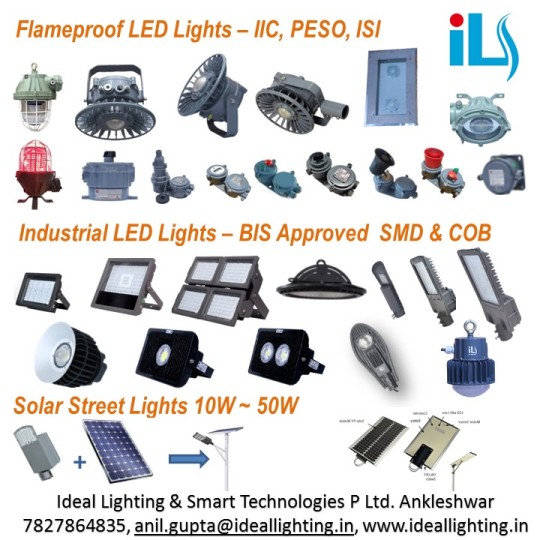Manufacturer of Flameproof LED Lights, FANs, ACs in Gujarat India
Don't wanna be here? Send us removal request.
Text

Flameproof LED Lights, FANs, ACs, manufacturer in Ankleshwar, Gujarat, India.
0 notes
Text
Explain flameproof lighting
Flameproof lighting, also known as explosion-proof lighting, is a specialized type of lighting designed to safely operate in hazardous environments where there is a risk of flammable gases, vapors, liquids, or combustible dust. These environments are typically found in industries such as oil and gas, chemical plants, mining, petrochemical facilities, and other areas where volatile substances are present.
The primary purpose of flameproof lighting is to prevent the ignition of flammable substances by containing any sparks, arcs, or heat generated within the lighting fixture. This is achieved through a robust and rugged construction that can withstand and contain potential explosions or ignitions within the enclosure.
Key features and characteristics of flameproof lighting include:
Enclosed Design: Flameproof luminaires are constructed with a tightly sealed enclosure that can withstand the pressure of an internal explosion. The enclosure is designed to contain any sparks or flames within it, preventing the release of hazardous gases or flames into the surrounding environment.
Robust Construction: Flameproof lighting fixtures are built with durable materials such as cast aluminum, stainless steel, or other materials that can withstand harsh conditions and impacts. The construction is designed to resist external elements, such as water, dust, and chemicals.
Seal and Gland System: Flameproof luminaires have specialized sealing systems with flameproof glands that ensure a tight seal at cable entry points, preventing the entry of flammable gases or dust into the fixture.
Heat Dissipation: Flameproof luminaires are designed to dissipate heat effectively, ensuring that the fixture remains within safe operating temperatures even during prolonged use.
Compliance with Standards: Flameproof lighting must adhere to specific national and international standards, such as IEC 60079 (International Electrotechnical Commission) and relevant local regulations. Compliance with these standards ensures that the lighting fixtures meet the necessary safety requirements for use in hazardous environments.
Flameproof lighting provides illumination in areas where safety is paramount. It helps to minimize the risk of explosions, fires, and other hazardous incidents, protecting both personnel and property. These lighting solutions are available in various types, including well glass lights, floodlights, high bay lights, and street lights, to suit different applications and mounting requirements.
It is important to consult with lighting experts and ensure that flameproof lighting fixtures are installed and maintained correctly to maintain their safety and performance.
Visit www.ideallighting.in for more details.
0 notes
Text
What is zone 1 and zone 2 in flameproof lights?
Zone 1 and Zone 2 are classification zones used to define the level of hazardous risk in flammable environments. These zones are defined in international standards and regulations, such as the IEC 60079 series, which specify requirements for electrical equipment, including flameproof lights, used in potentially explosive atmospheres.
Zone 1: Zone 1 is an area where an explosive atmosphere is likely to occur during normal operation. In this zone, flammable gases, vapors, or liquids are present in sufficient quantities to pose a risk of explosion. Examples of Zone 1 environments include areas around storage tanks, pipelines, or processing equipment where flammable substances are handled or processed.
Zone 2: Zone 2 is an area where an explosive atmosphere is not likely to occur during normal operation but may occur intermittently due to abnormal conditions or malfunctions. In this zone, flammable substances are present, but in lower quantities or for shorter durations compared to Zone 1. Examples of Zone 2 environments include areas adjacent to Zone 1 locations or where occasional releases of flammable substances may occur.
When selecting flameproof lights for hazardous areas, it is essential to consider the appropriate zone classification for the specific application. Flameproof lights designed for Zone 1 areas have a higher level of protection and are specifically engineered to withstand and contain potential explosions within their enclosures. These luminaires are designed to prevent ignition and minimize the risk of releasing hazardous substances into the surrounding environment.
Flameproof lights for Zone 2 areas may have slightly different design considerations, as the risk level is lower. However, they still need to meet safety standards and provide reliable operation in potentially explosive atmospheres.
It is crucial to consult and comply with relevant national and international regulations and standards when selecting and installing flameproof lights in hazardous areas. This ensures the safety of personnel and equipment while mitigating the risk of explosions or accidents in these environments.
Visit www.ideallighting.in for more details.
1 note
·
View note